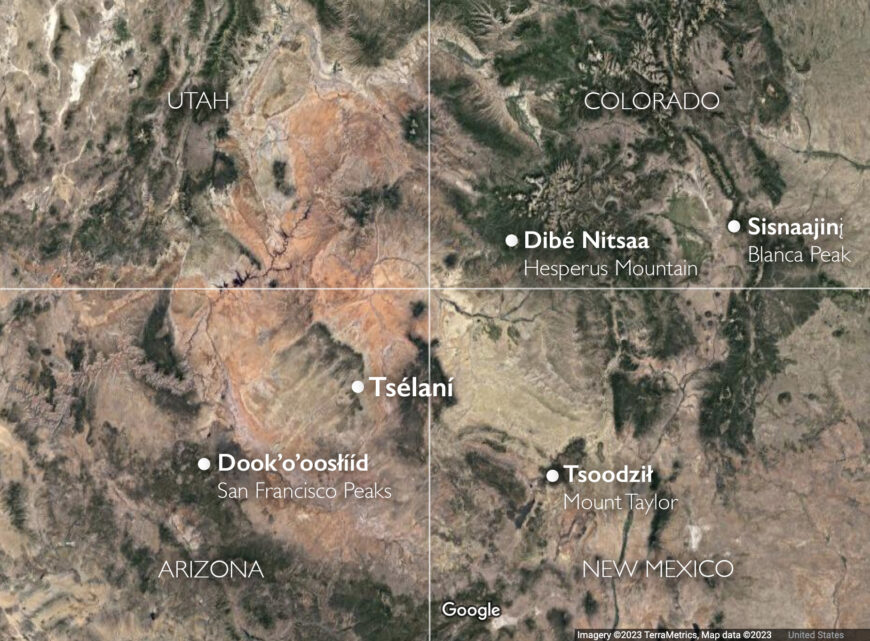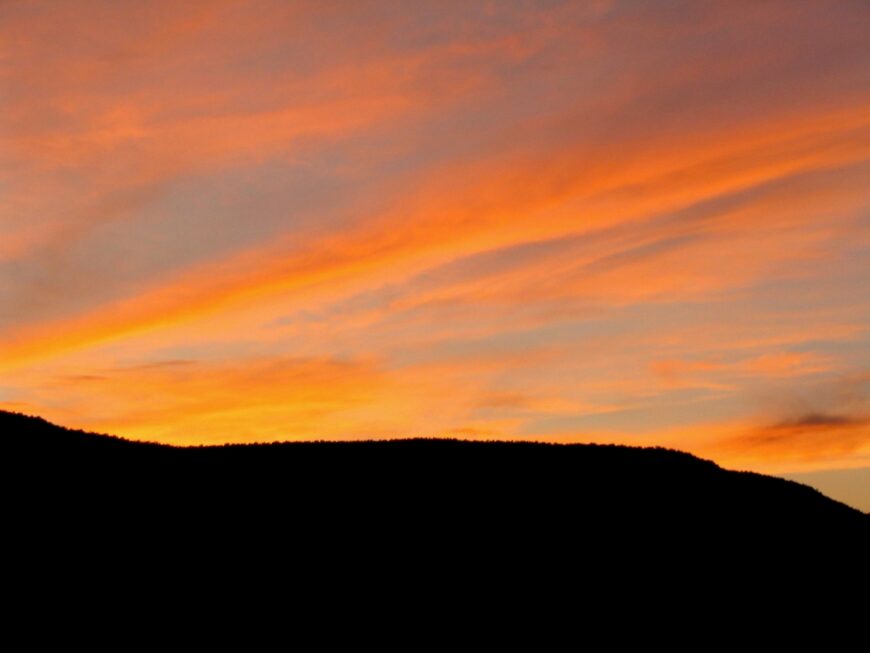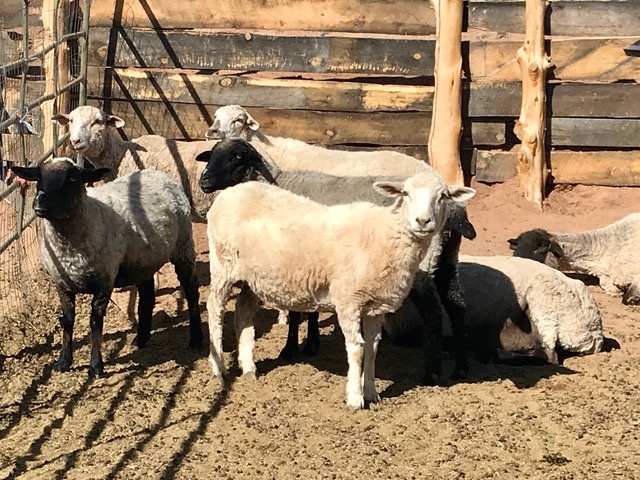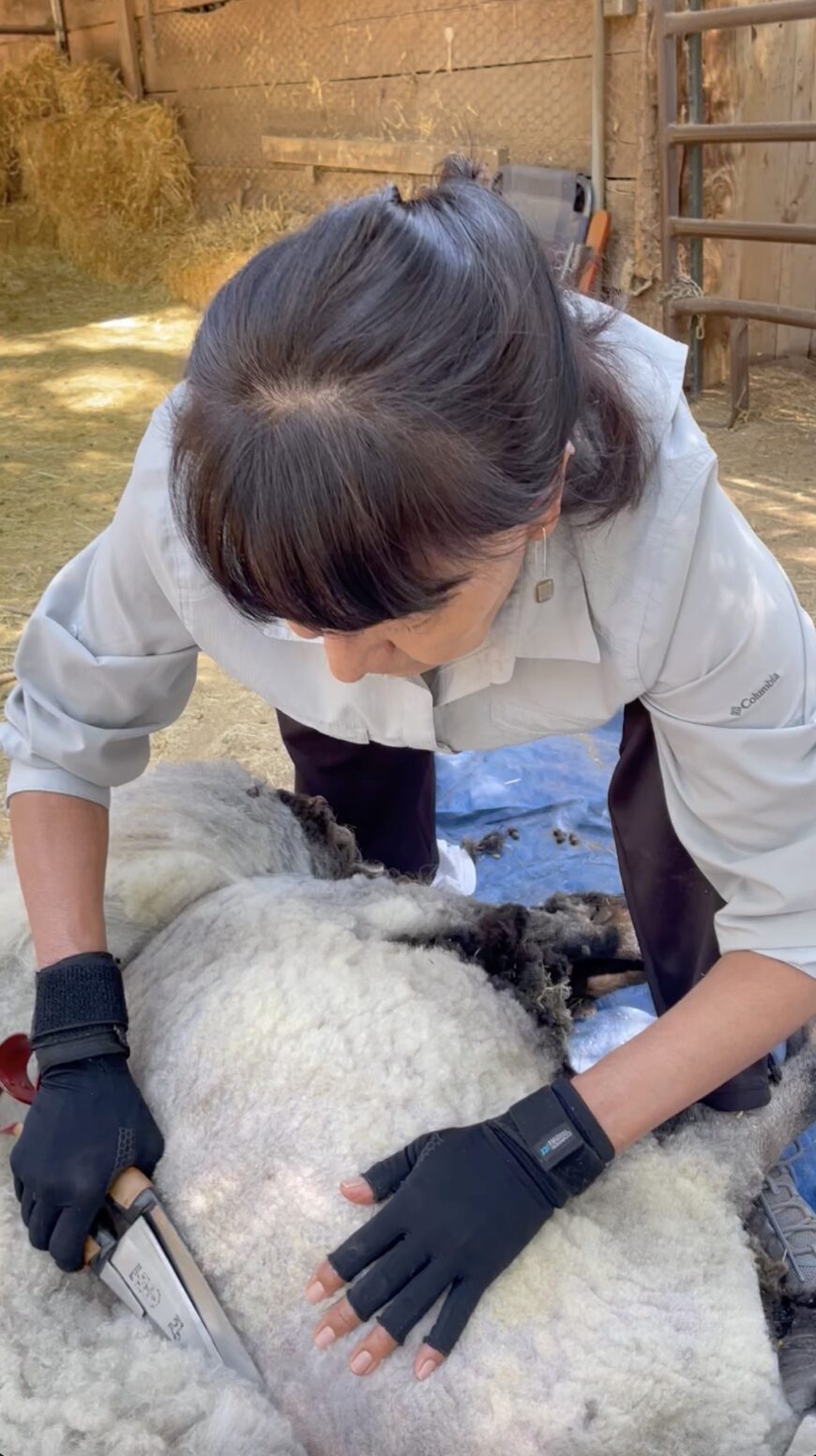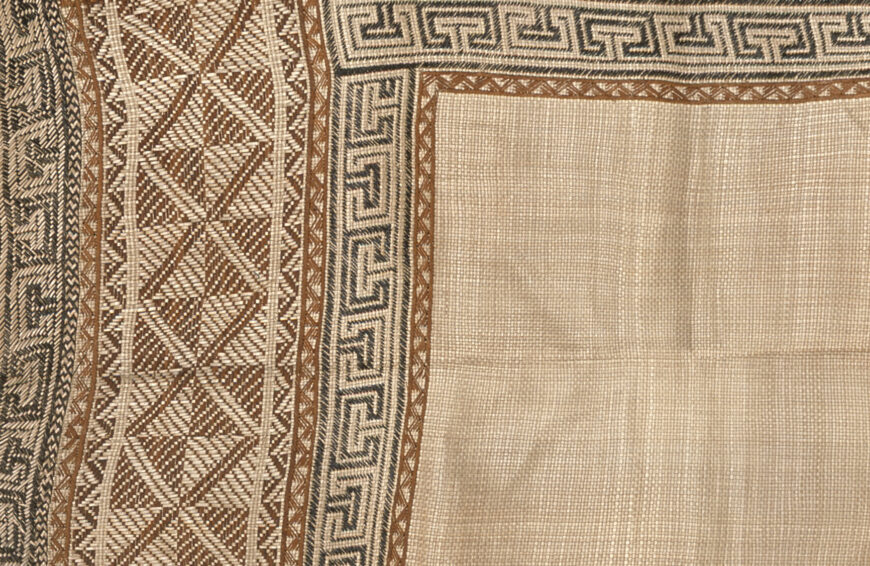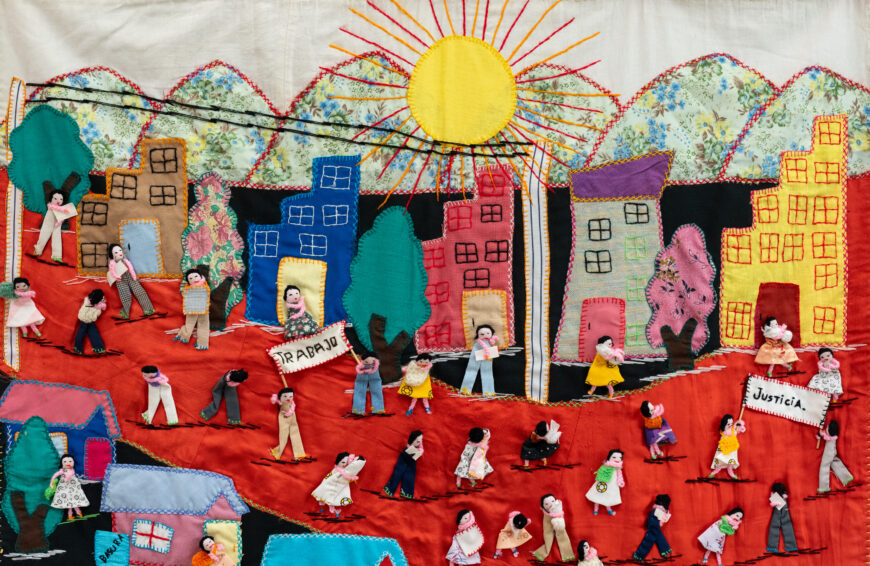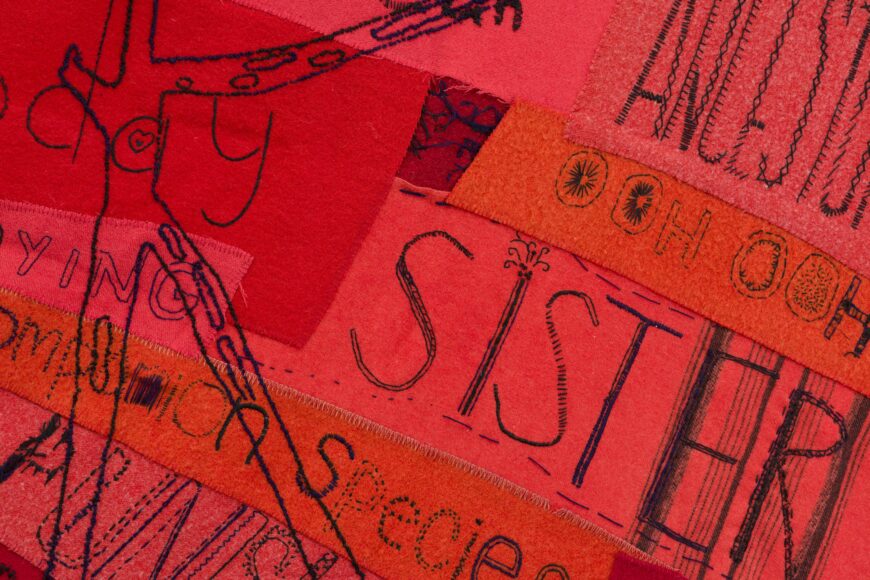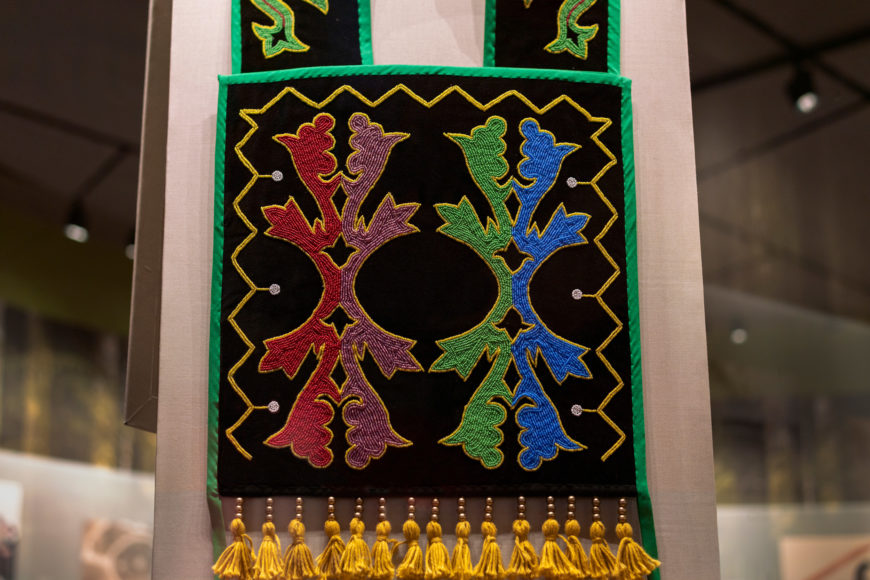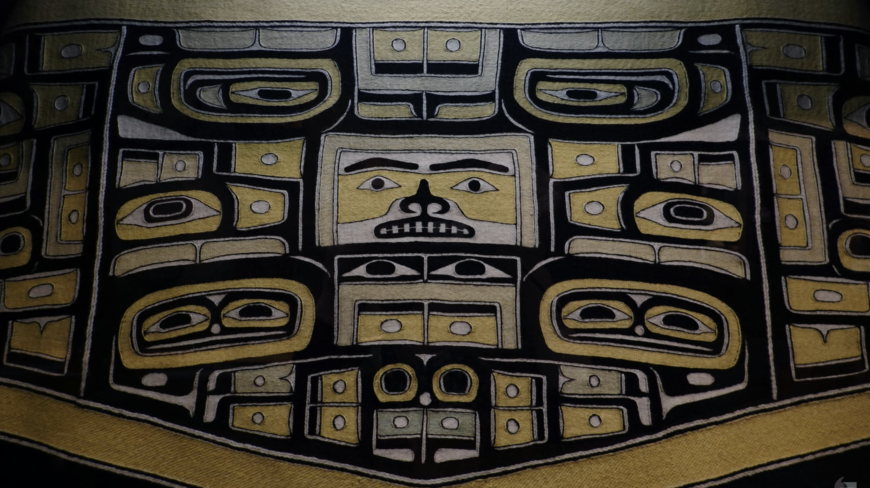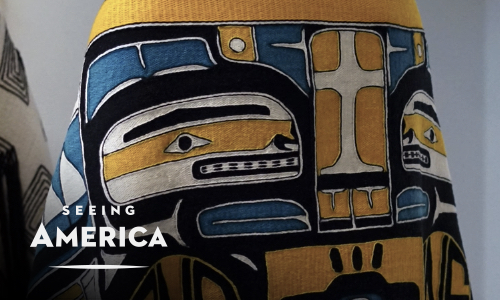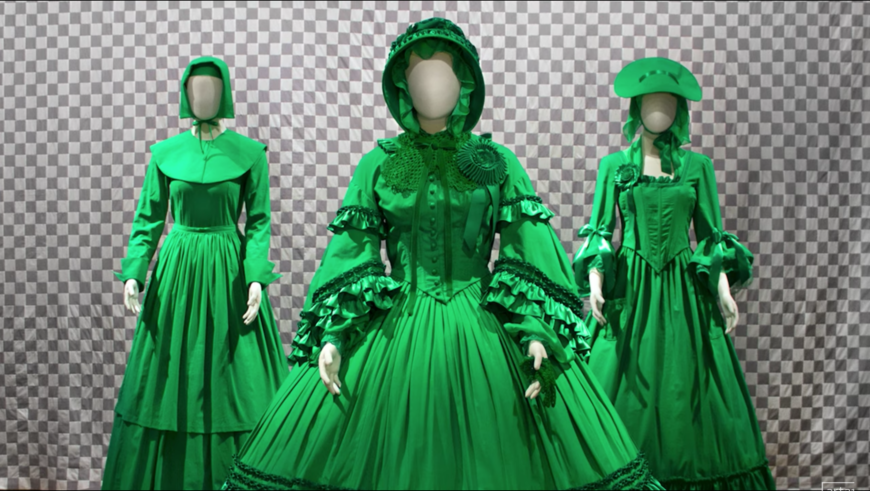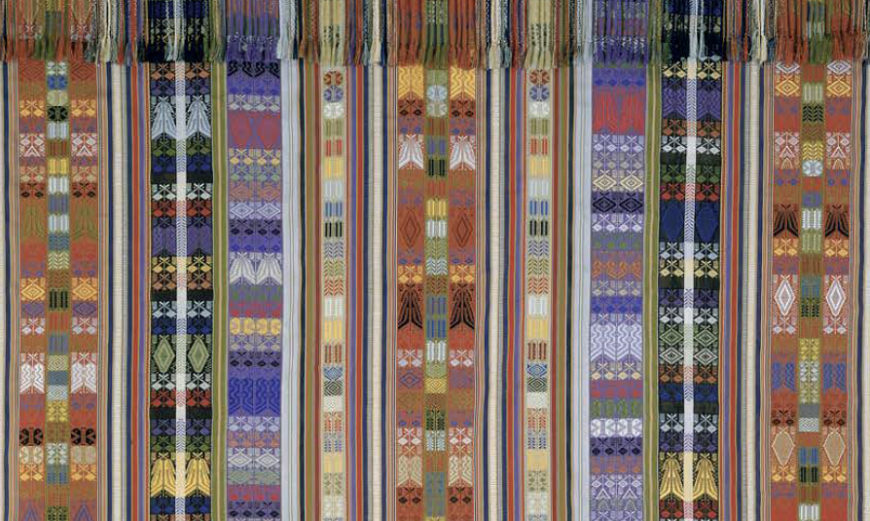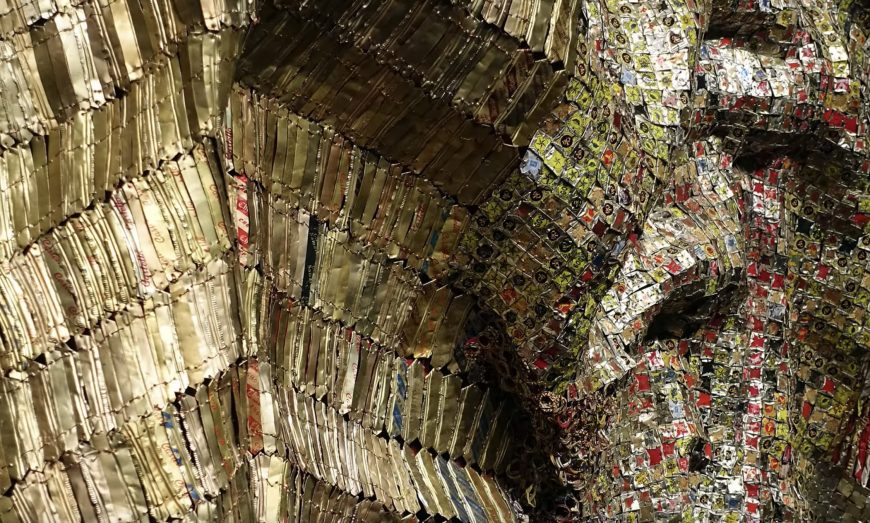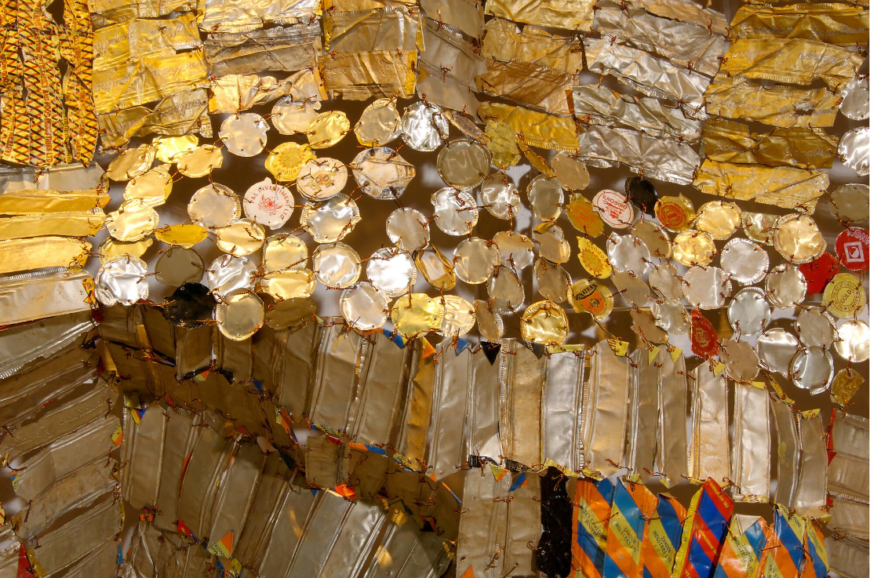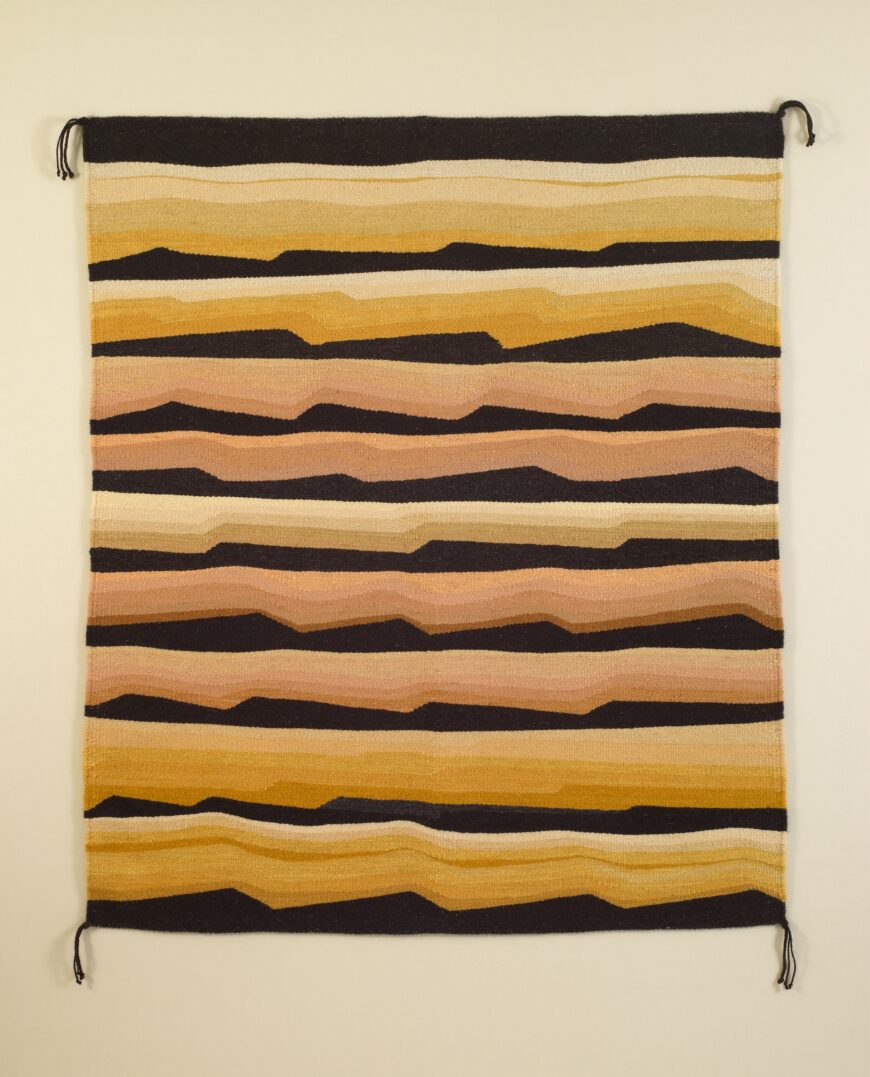
DY Begay, The Edge, 2013, wool with natural dye, 40 1/4 x 34 3/4 inches, each corner tassel length: 3 3/4 inches (Saint Louis Art Museum) © DY Begay
Looking at this work, what colors do you see? How many different shades of those colors can you make out? What sensation of space do you get from the way the colors are layered? Do you get a sense of vibration, like a visual echo that reverberates out into the distance?
This tapestry, titled The Edge, hangs a little over 3 feet long and portrays the natural landscape formations of the Navajo land (also known as the Diné bíkéyah or Dinétah), which corresponds to a region encompassing parts of modern Arizona, New Mexico, Utah, and Colorado. This is where textile artist DY Begay’s birthplace of Tsélaní is located in the heart of Navajo Nation in Arizona, and where her family has lived for generations. Traditionally marked by four mountains—Blanca Peak (Sisnaajinį́), Mount Taylor (Tsoodził), the San Francisco Peaks (Dook’o’oosłííd), and Hesperus Mountain (Dibé Nitsaa)—these four natural landmarks delineate an area within the Four Corners region of the United States, but also demarcate a spiritual space for the Diné, or Navajo, people.
The landscape
The four mountains encompassing Diné bíkéyah are connected to the story of Spider Woman (Na’ashjéii Asdzáá), one of the most important deities of traditional Navajo religion and its creation story. It is believed that Spider Woman visited each of the four sacred mountains, gathering the materials she needed to weave her web of the universe. These included wood for a loom, plants for colored dyes, patterns for designs, and, finally, prayers. [1] The four peaks surrounding Diné bíkéyah are associated with specific colors (white, blue, yellow, and black, respectively), as well as attributes, such as thinking, planning, action, and completion, which one might connect with the process of weaving itself. [2] Spider Woman then taught the people of Diné bíkéyah how to weave, and in doing so, taught the Diné to create beauty in their own lives. Yet this “Beauty Way” (hózhó) is much more than just about achieving aesthetic appeal. It is a teaching of balance within the mind, body, and soul. Thus, for Diné artists such as DY Begay, weaving is a spiritual practice. Weaving connects the current generation to previous and future generations as well as to cosmological beings such as Spider Woman and to the overall balance and harmony of the Diné community and its beliefs.
The environment of Diné bíkéyah is inspirational to Begay, and The Edge is a contemporary tapestry that captures the colors and the formations Begay sees when she looks out across all four directions from her hogan (her traditional Navajo home). Begay’s creativity is animated by natural landscapes and by her love for the incredible array of colors to be experienced when immersed in this place. This includes colors of the earth, vegetation, rocks, skies, waters, and different times of day and night, all of which is then translated onto her loom.
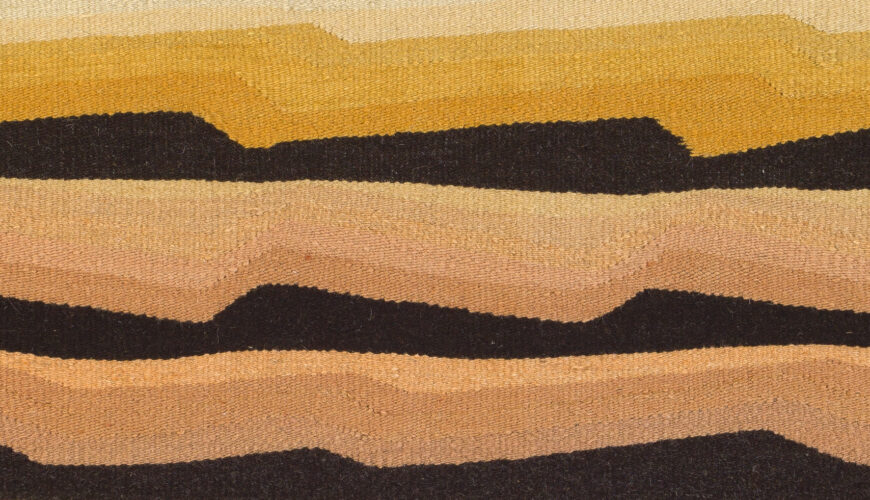
Woven horizontal bands of color (detail), DY Begay, The Edge, 2013, wool with natural dye, 40 1/4 x 34 3/4 inches, each corner tassel length: 3 3/4 inches (Saint Louis Art Museum) © DY Begay
Seen from afar, The Edge might appear to be a painting, but up close you can see rows upon rows of sheep’s wool yarns, woven together tightly and neatly, each manifesting a unique shade of color. Looking closely at the flow of the horizontal bands of color, we can see how they vary in thickness, some thin and some broad. Looking closely at each band, you can decipher that multiple shades, or tones, of color, are in fact stacked upon each other. As a contemporary artist, DY Begay uses traditional Navajo practices (explained later) to create abstract designs that allow color, shape, and texture to suggest the feeling of being in the environment of Diné bíkéyah. In The Edge, the soft, gentle, undulating formations with subtle variations in color are inspired by witnessing the sky over the horizon at sunset.
One of the first things we notice are the dark shapes that span the textile horizontally. Next, we see layered rows of color outlining the dark shapes. Here, Begay lays out a pattern in this work which suggests the forms of mesas within the landscape of Diné bíkéyah. Mesas, long, flat-topped mountains that rise high above the horizon, are a dominant feature of this landscape. Indeed, Tsélaní (DY Begay’s birthplace) is a Navajo word that means “many rocks.” At sunrise and sunset the mesas form dark, almost abstract shapes against a sky full of richly hued tones of yellow, reds, and browns. As Begay says, “My focus for The Edge was to integrate the soft formations of the sky and to intensify the sunset colors. I settled on weaving powerful, slanted shapes complimenting the soft tones of evening hues.” Yet, in addition to the literal interpretation available of The Edge, another, more poetic understanding is present as well. As Begay states: “The Edge [also refers to] a peaceful sense of solitude (an intimate thought) with a defined edge.” Thus, in this work we glimpse both the physical as well as more abstract power of the natural landscape of Diné bíkéyah for Begay.
Weaving is learning, sheep is life
Begay, who is a fifth-generation weaver, was born to the Tótshoníí clan (Big Water) and for the Táchii’nii clan (Red Running into Water/Earth). Her maternal grandfather is of the Tséńjíkiní clan (Among the Cliff Dwellers) and her paternal grandfather is of the Ashįihí clan (Salt People). Her mother, her grandmothers, and her great grandmothers were also weavers, and she learned to weave at an early age. In Diné culture weaving is passed down matrilineally, and as Begay explains, was taught to her by her elders as a skill that was also essential to survival:
We always heard as young girls that you have to learn how to weave, if you don’t you might starve, you might not find clothing, you might not stay warm. I come from a very traditional family, and we were told these stories over and over when we were growing up, and to me it’s a reminder why it’s very important to me to maintain this special tradition, the weaving process.
Begay weaves her contemporary tapestries on a loom in her home and with her family raises the sheep that produce the woolen yarns which they dye using local plants. The wool comes from a small herd of eight to ten Churro sheep her sister Berdina maintains on their land at Tsélaní. Sheep are culturally important to Navajo families, and they are treated well to recognize that they provide food for sustenance and wool for weaving. As Begay explains:
…it’s not just about weaving. We also have to acknowledge the sheep, and where the sheep meal comes from. We claim that Sheep is Life.
Churro sheep were first brought to the Americas by the Spanish in the 16th century and have played an integral role in Navajo life for centuries, including as a food source, maintaining the sustainability of the landscape, and in providing wool for textile production. Churro sheep have traits that make them particularly resilient in the dry environment of the American southwest. For example, they can travel long distances to find food and water, and their wool, which has a lower lanolin content than other breeds of sheep, is advantageous in the sandy and windy conditions of the Diné bíkéyah as particles do not get as entrapped in their wool. Churro wool is also easier to clean than other types of wool, such as Merino, which often require chemicals and lots of water (which is scarce in the southwest) to process. When spun, Churro wool is thicker than other types of wool with a higher lanolin content and is better suited to absorb the natural dyes that Begay and other Diné weavers use.
In early or mid-spring Begay and her family gather to shear the sheep, meaning they cut off the sheep’s wool, which has grown thick over the winter. The shearing is done by hand, using large, flat scissors. After shearing, the fleece is washed by hand, dried, carded, and then hand-spun into long yarns, which can be dyed if desired. Begay’s sheep, which are different shades of white, brown, gray, and black, produce wool which has a natural variety of hues, producing a wider array of colors after the dyeing process. [3] Begay states that almost any plant can give some color and she experiments with many species that are available around her home. For example, to create The Edge, Begay used 31 colors, and as part of her artistic practice, Begay documents the plants she derives the colors from for each of her tapestries.

Left: Natural color yarn dyed, 2022 (photo: DY Begay) © DY Begay; right: Navajo tea plant (Ch’ilgohwehih), Tsélaní, 2022 (photo: DY Begay) © DY Begay
Making colors
Twice a year, usually in spring and early fall, Begay does a “dye retreat” with her sisters, who are also weavers. They process the dyes derived from flowers, roots, barks, as well as from lichens harvested from rocks around Diné bíkéyah, then immerse their wool yarns into big pots of hot water tinted with these different dyes. Experience and knowledge of traditional environmental practices guide how they gather and prepare these organic materials so they can show their true colors. For example, certain dye sources may only be available in particular seasons or need to be harvested in a way that ensures sustainability for future gatherings and generations.

DY Begay, The Edge, 2013, wool with natural dye, 40 1/4 x 34 3/4 inches, each corner tassel length: 3 3/4 inches (Saint Louis Art Museum) © DY Begay
Begay’s paternal grandmother, Desbah Nez, taught her which plants provide specific colors and where to find them within Diné bíkéyah. In addition to the dyeing lessons her grandmother provided, Begay also took fiber art classes while she attended Arizona State University. The courses covered many areas of fiber construction and she learned how to control colors by using additives such as alum to modify and stabilize the natural colors from plant sources. Today, Begay collects many of the same plants that her grandmother used. She enjoys experimenting with new dye variations to get the many subtleties of color that emerge on her loom.
To create the range of yellow and orange hues seen in The Edge, Begay harvested Navajo tea plant (Ch’ilgohwehih) from Tsélaní. This plant can yield a variety of yellow and orange colors. To create hues of yellow to yellow/green, Rocky Mountain Bee Plant (known as Waa’ in Navajo) is used. Chamizo, or Diwozhiiłbaih in Navajo, produces a bright to muddy yellow. Lastly, wild rhubarb or Chaad’iniih, makes medium to dark brown hues on Churro yarn that we see in this tapestry as well.
Hanging today in the Saint Louis Art Museum in Missouri, The Edge is an expression of DY Begay’s heritage, the spiritual practice of weaving, and her experiences living in Diné bíkéyah. But it is also a contemporary abstract work made to share these experiences with a larger audience. Inspired by memories of the specific beauty of Diné bíkéyah, The Edge also conveys universal feelings of witnessing the beauty and power of nature, of feeling small but part of a larger whole, and of being present within a specific moment in time.


